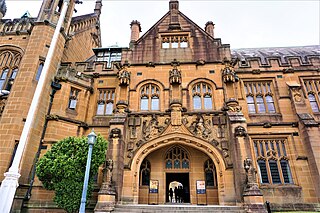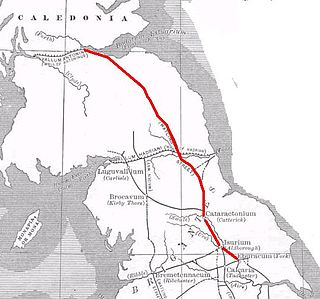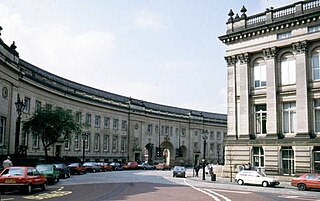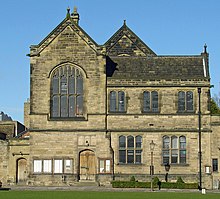
The Ashmolean Museum of Art and Archaeology on Beaumont Street, Oxford, England, is Britain's first public museum. Its first building was erected in 1678–1683 to house the cabinet of curiosities that Elias Ashmole gave to the University of Oxford in 1677. It is also the world's second university museum, after the establishment of the Kunstmuseum Basel in 1661 by the University of Basel.

There are many Roman sites in Great Britain that are open to the public. There are also many sites that do not require special access, including Roman roads, and sites that have not been uncovered.

The Nicholson Museum was an archaeological museum at the University of Sydney home to the Nicholson Collection, the largest collection of antiquities in both Australia and the Southern Hemisphere. Founded in 1860, the collection spans the ancient world with primary collection areas including ancient Egypt, Greece, Italy, Cyprus, and the Near East. The museum closed permanently in February 2020, and the Nicholson Collection is now housed in the Chau Chak Wing Museum at the University of Sydney, open from November 2020. The museum was located in the main quadrangle of the University.

Piercebridge is a village and civil parish in the borough of Darlington and the ceremonial county of Durham, England. The population of the civil parish as of the 2011 census was 113. It is situated a few miles west of the town of Darlington. It is on the site of a Roman fort of AD 260–270, which was built at the point where Dere Street crossed the River Tees. Part of the fort is under the village green. The village is sited where the York-Newstead Roman road known as Dere Street crosses the River Tees.

Shincliffe is a village and civil parish in County Durham, England. The parish population was 1,796. It is situated just over 1 mile (1.6 km) to the south-east of Durham city centre, on the A177 road to Stockton. Shincliffe is also a civil and ecclesiastical parish consisting of Shincliffe Village, High Shincliffe, Sherburn House and Whitwell House.

Dere Street or Deere Street is a modern designation of a Roman road which ran north from Eboracum (York), crossing the Stanegate at Corbridge and continuing beyond into what is now Scotland, later at least as far as the Antonine Wall. It was the Romans' major route for communications and supplies to the north and to Scotland. Portions of its route are still followed by modern roads, including the A1(M), the B6275 road through Piercebridge, where Dere Street crosses the River Tees, and the A68 north of Corbridge in Northumberland.

The Petrie Museum of Egyptian Archaeology in London is part of University College London Museums and Collections. The museum contains 80,000 objects, making it one of the world's largest collections of Egyptian and Sudanese material. It is designated under the Arts Council England Designation Scheme as being of "national and international importance".
William Greenwell, was an English archaeologist and Church of England priest.

Lanchester is a village and civil parish in County Durham, England, 8 miles (13 km) west of Durham and 5 miles (8 km) from Consett. It had a population at the 2011 Census of 4,054.

Piercebridge Roman Fort is a scheduled ancient monument situated in the village of Piercebridge on the banks of the River Tees in modern-day County Durham, England. There were Romans here from about AD 70 until at least the early 5th century. There was an associated vicus and bath house at Piercebridge, and another vicus and a villa south of the river at Cliffe. The Victorians used carved stones from this site when they built St Mary's church at Gainford. Part of the site is under Piercebridge village green.

Piercebridge Roman Bridge is the ruin of a Roman bridge over the River Tees, northern England. It is near the villages of Cliffe and Piercebridge, County Durham.

Eric Barff Birley,, was a British historian and archaeologist, particularly associated with the excavation of the forts of Hadrian's Wall, notably at Vindolanda.
The year 2007 in archaeology

Bolton Museum is a public museum, aquarium and art gallery in the town of Bolton, England, owned by Bolton Metropolitan Borough Council. The museum is housed within the grade II listed Le Mans Crescent near Bolton Town Hall and shares its main entrance with the central library in a purpose-built civic centre.

Vinovia or Vinovium was a Roman fort and settlement situated just over 1 mile (1.6 km) to the north of the town of Bishop Auckland on the banks of the River Wear in County Durham, England. The fort was the site of a hamlet until the late Middle Ages, but the modern-day village of Binchester is about 2 miles (3 km) to the east, near Spennymoor. The ruins are now known as the Binchester Roman Fort.
The Oriental Museum, formerly the Gulbenkian Museum of Oriental Art and Archaeology, is a museum of the University of Durham in England. The museum has a collection of more than 23,500 Chinese, Egyptian, Korean, Indian, Japanese and other far east and Asian artefacts. The museum was founded due to the need to house an increasing collection of Oriental artefacts used by the School of Oriental Studies, that were previously housed around the university. The museum's Chinese and Egyptian collections were 'designated' by the Museums, Libraries and Archives Council (MLA), now the Arts Council England as being of "national and international importance".

The MACM, the Mougins Museum of Classical Art, private museum inaugurated in June 2011 in the village of Mougins in the Alpes-Maritimes department, France has closed its doors in August 2023 to make way for a new museum, FAMM opening in June 2024.

Heathery Burn Cave is a cave near Stanhope, County Durham, England, in which a large collection of Late Bronze Age weapons and tools was discovered and excavated between 1859 and 1872.
Jennifer Foster is an English scholar of prehistoric and medieval archaeology, who specializes in the study of artifacts, particularly metalwork.
There are 292 scheduled monuments in County Durham, in North East England. These protected sites date from the Neolithic period in some cases and include barrows, a medieval hospital, ancient Roman sites, castle ruins, Iron Age forts, bridges and Anglo-Saxon crosses. In the United Kingdom, the scheduling of monuments was first initiated to ensure the preservation of "nationally important" archaeological sites or historic buildings. Protection is given to scheduled monuments under the Ancient Monuments and Archaeological Areas Act 1979.




















